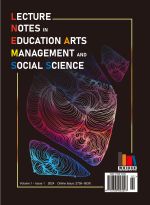Development of a Curriculum Based on the “1+3 Arts Integration Education” Model: A Case Study of the Perception and Arts Integration Course
Keywords:
Art education, Art integration, Arts integrated education, Cultural arts education, Perception and arts integrationAbstract
This study is grounded in the “1+3 Arts Integrated Education Curriculum and Teaching Methodology,” which caters to the evolving demands of university arts education amidst contemporary social and historical contexts. By emphasizing one primary discipline (whether literature, visual arts, music, or film) and integrating the remaining three, “1+3 Arts Integrated Education” transcends the traditional boundaries between integrated and convergent educational approaches. The Perception and Arts Integration course was specifically devised to investigate how various art genres correlate with senses and perception, and how these correlations manifest artistically. The curriculum underwent a comprehensive design process involving academic conferences, guest lectures, workshops, and case studies. This led to the implementation of a pilot extracurricular class, followed by the formal development of the course. Through expert team teaching, the course seamlessly integrated theoretical knowledge with practical applications, culminating in the completion of final projects. Students reaped the benefits of engaging in a diverse array of arts integration activities, broadened learning opportunities, in-depth exploration of their chosen fields, and heightened awareness of the interconnectedness between perception and arts integration.
References
Ministry of Culture, Sports and Tourism, 2014, Mid- to Long-Term Development Plan for Cultural Arts Education, https://www.mcst.go.kr/.
Lee AR, 2015, Perceptions and Needs of Early Childhood Teachers and Elementary School Teachers Regarding the Necessity of Arts Convergence Education, thesis, Soongsil University.
Park CE, 2009, Difficulties in Applying Integrated Curriculum Theory and Practice. Arts and Education Research, 4(1): 1–25.
Ministry of Education, Science and Technology, 2014, Elementary School Teacher’s Guidebook Integrated Curriculum, Jihaksa, Seoul.
Hong Y, 2018, Application and Theoretical Development of Integrated Curriculum in the Case of the United States. Integrated Curriculum Studies, 12(4): 251–264.
Kim HJ, 2020, Exploring a Theatre-Centred Integrated Arts Education Programme. Arts and Education Research, 15(6): 37–53.
CNAEO (Consortium of National Arts Education Organisations), 2002, Authentic Connections: Interdisciplinary Work in the Arts.
Tae JM, 2011, A Case Analysis of Arts Integration Education in K-12 Schools in the United States as a Curriculum Reform. Arts Education Research, 9(3): 17–32.
Im K, 2011, Arts Integration Education in the United States and Its Implications for Korean Education. Korean Education, 38(3): 33–52.
Lee EJ, 2023, A Study on Curriculum and Teaching and Learning Methods of 1+3 Arts Integration Education - Focusing on the Development and Operation of ‘From Cultural Experience to Application1’. Korean Literary and Creative Works, 22(3): 35–61.
Loepp FL, 1999, Models of Curriculum Integration. Journal of Technology Studies, 25(2): 21–25.
Lee B, 2022, A Study on Teaching Methods for Arts Integration Education Based on Ruth Bernstein’s Theory. Arts and Education Research, 17(1): 75–102.
Hwang E, 2023, A Study on the Practice of Arts Convergence Education in Korean Higher Education Institutions. Culture and Convergence, 45(9): 1153–1164.
Bernstein R, 2018, The Birth of Thought, Echo’s Books, Seoul.
Baek YS, Park HJ, et al., 2012, Basic Research for Establishing the Implementation Direction of STEAM, Korea Science and Creativity Foundation, Korea.
Choi YH, Noh JA, et al., 2012, Development of STEAM Curriculum Model for Fostering Creative Convergence Talents. Korean Journal of Technology Education, 12(3): 63–87.
Jeon YM, 2022, An Investigation of Instructors’ and Learners’ Perceptions of University Convergence Education. Open Educational Research, 30(1): 21–43.

